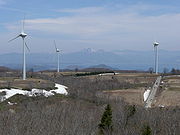
Wind power in Japan
Encyclopedia

2011 Japanese nuclear accidents
This is a list of articles describing aspects of the nuclear shut-downs, failures, and nuclear meltdowns triggered by the 2011 Tōhoku earthquake and tsunami.-Fukushima nuclear power plants:* Fukushima I Nuclear Power Plant...
are pushing wind power to the forefront as a safer and more reliable alternative to meet the country's future electricity requirements. None of Japan's commercial wind turbines, totaling over 2300 MW in nameplate capacity
Nameplate capacity
Nameplate capacity, also known as the rated capacity, nominal capacity, installed capacity or maximum effect, refers to the intended technical full–load sustained output of a facility such as a power plant, a chemical plant, fuel plant, metal refinery, mine, and many others.For dispatchable power,...
, failed as a result of the 2011 Tōhoku earthquake and tsunami
2011 Tōhoku earthquake and tsunami
The 2011 earthquake off the Pacific coast of Tohoku, also known as the 2011 Tohoku earthquake, or the Great East Japan Earthquake, was a magnitude 9.0 undersea megathrust earthquake off the coast of Japan that occurred at 14:46 JST on Friday, 11 March 2011, with the epicenter approximately east...
, including the Kamisu offshore wind farm directly hit by the tsunami.
Notable projects
The Shin Izumo Wind Farm owned by Eurus EnergyEurus Energy
Eurus Energy Holdings Corporation is a holding company of the Eurus Energy Group, Japan's largest wind power developer. Eurus Energy is a joint venture of the Tokyo Electric Power Company and Toyota Tsusho Corporation and is headquartered in Minato-ku, Tokyo...
is the largest wind farm in Japan as of 2011, comprising 26 turbines with a total nameplate capacity
Nameplate capacity
Nameplate capacity, also known as the rated capacity, nominal capacity, installed capacity or maximum effect, refers to the intended technical full–load sustained output of a facility such as a power plant, a chemical plant, fuel plant, metal refinery, mine, and many others.For dispatchable power,...
of 78 megawatts.
, Japan plans to build a pilot floating wind farm
Floating wind turbine
A floating wind turbine is an offshore wind turbine mounted on a floating structure that allows the turbine to generate electricity in water depths where bottom-mounted towers are not feasible...
, with six 2-megawatt turbines, off the Fukushima coast
Fukushima Prefecture
is a prefecture of Japan located in the Tōhoku region on the island of Honshu. The capital is the city of Fukushima.-History:Until the Meiji Restoration, the area of Fukushima prefecture was known as Mutsu Province....
. After the evaluation phase is complete in 2016, "Japan plans to build as many as 80 floating wind turbines off Fukushima by 2020."
Capacity
In 2009, Japan's historical installed wind power capacity in megawatts (MW) was:| Year | Capacity | Change | % Change |
|---|---|---|---|
| 2000 | 136 | ||
| 2001 | 302 | 166 | 122.06% |
| 2002 | 338 | 36 | 11.92% |
| 2003 | 580 | 242 | 71.60% |
| 2004 | 809 | 229 | 39.48% |
| 2005 | 1,049 | 240 | 29.67% |
| 2006 | 1,309 | 260 | 24.79% |
| 2007 | 1,538 | 229 | 17.49% |
| 2008 | 1,880 | 342 | 22.24% |
| 2009 | 2,085 | 205 | 10.9% |
| 2010 | 2,304 | 219 | 10.5% |
External links
- http://jwpa.jp/ - Japan Wind Power Association official webpage

